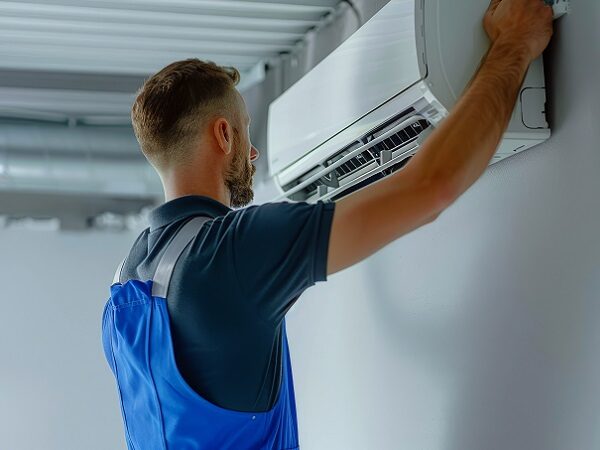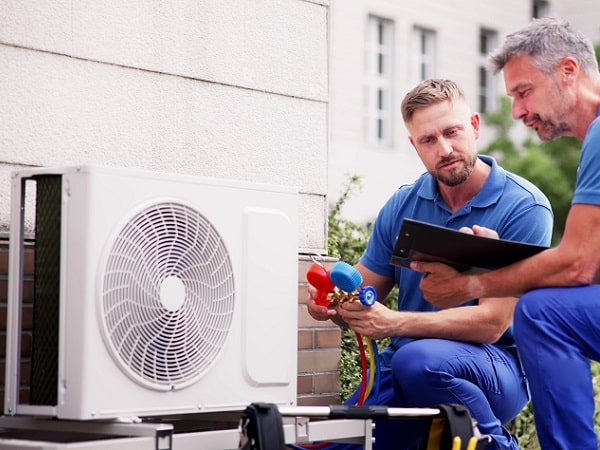With the UK experiencing more unpredictable weather, more people are looking to control their indoor climate effectively. HVAC has become a common term, often used interchangeably with air conditioning. However, HVAC includes more than just air conditioning. So, what exactly is HVAC, and how does it differ from air conditioning? How can it keep your home or office at the perfect temperature, regardless of the weather?
We all want to live and work in a calm, cool, and dry environment. From the draughtiest warehouse to the smallest flats, air control is always important for keeping everyone comfortable and productive.
In this article, we’ll explain what HVAC is, how these systems work, their benefits, and the differences between HVAC and air conditioning.
What is HVAC?
This is one of the most common questions our clients ask – “What does HVAC stand for?”
HVAC stands for heating, ventilation, and air conditioning and refers to the various systems used for moving air between indoor and outdoor areas, along with heating and cooling both residential and commercial buildings.
These systems are designed to maintain an optimal indoor environment by controlling temperature, humidity, and air quality, and maintaining proper ventilation year-round.
An HVAC system might include the following, in different combinations:
- Boilers
- Ducts and moisture vents
- Air conditioning units
A brief history and evolution of HVAC systems
Would you believe us if we told you HVAC systems can be traced back to ancient civilisations? It might sound surprising, but it’s true!
The Romans, for instance, developed one of the first heating systems known as hypocausts. These systems were used to heat public baths and private homes by circulating hot air beneath raised floors and through walls.
The modern concept of HVAC began to take shape in the 19th century. In 1824, Angier March Perkins invented the steam heating system, which was widely adopted in large buildings, factories, and later, homes. Additionally, in the mid-1800s, John Gorrie, an American doctor, invented a refrigeration machine to cool the air for his patients, laying the groundwork for modern air conditioning.
The 20th century brought rapid advancements in HVAC technology. In 1902, Willis Carrier invented the first modern air conditioning system to control humidity in a printing plant. The introduction of thermostats during this period also enabled more precise temperature control, enhancing the efficiency and convenience of HVAC systems.
After World War II, the demand for efficient heating, cooling, and ventilation solutions grew significantly, leading to the widespread adoption of central heating and air conditioning systems. Today, HVAC systems continue to evolve, focusing on energy efficiency, sustainability, and smart technology. Modern developments include high-efficiency boilers, heat pumps, and advanced air filtration systems.
In summary, HVAC systems have come a long way from their ancient origins to the sophisticated, energy-efficient systems we rely on today!
How Does HVAC Work?
Understanding how HVAC systems work can help you appreciate their role in creating a comfortable and healthy indoor environment. Each component and process is designed to ensure your indoor space, whether home, office, factory, shop or other commercial space, remains at the perfect temperature with clean, fresh, air.
HVAC systems perform three basic functions:
- Heating
- Cooling
- Ventilation
In some cases, different HVAC components work independently. However, combined systems are more common than ever – this means that all components work together, including AC and central heating systems.
Heating
When temperatures drop, the heating components of a HVAC system kick in to keep the indoor environment warm and cosy.
The key components of a heating system can include:
- Furnaces that burn natural gas, oil, or use electricity to generate heat;
- Boilers that heat water to produce steam or hot water, which is then circulated through radiators or underfloor heating systems;
- Heat pumps that extract heat from the outside air (even when it’s cold) and transfer it indoors.
Cooling
During the summer months, the cooling components of your HVAc system work to keep indoor spaces cool and comfortable.
A cooling system can include:
- Air conditioners that use use a refrigerant to absorb heat from indoor air and expel it outside;
- Chillers (typically used in larger buildings) that remove heat from the air using chilled water;
- Duct-free systems (also known as mini-splits) that consist of an outdoor unit connected to one or more indoor units.
Ventilation
Ventilation is all about maintaining good indoor air quality by providing fresh air and removing stale air, moisture, and pollutants.
Your HVAC system works on an ‘inside out’ principle – the internal systems differ from building to building, depending on needs, but they all rely on outdoor air. The HVAC ventilation system brings fresh air in from the outside in one of two ways.
Natural ventilation
Natural ventilation relies on wind and buoyancy to move air through windows, doors, and vents. Historically, natural ventilation was the only option available, so many older buildings feature air shafts and other designs to facilitate air exchange.
Because of this, natural ventilation doesn’t require any special equipment or construction – it’s as easy as opening a window or a door! But, if you live near a motorway or industrial area, natural ventilation might not be ideal since pollutants and particulates from outside can enter your home.
Mechanical ventilation
Mechanical ventilation involves using mechanisms, like fans, and ductwork to control air flow into and out of a building. Systems like exhaust fans, supply fans, and balanced systems (which use both) ensure a consistent supply of fresh air through purpose-built air inlets, while removing stale air.
Advanced systems may include energy recovery ventilators or heat recovery ventilators, which transfer heat between incoming and outgoing air to boost efficiency. As the air circulates, it helps remove dust, dirt, grime, and particles, reducing allergens and improving overall air quality. The air is then heated or cooled and dehumidified as necessary. Once conditioned, the air travels through ducts and vents, reaching the desired rooms or spaces to maintain a comfortable indoor environment.
Air filters also capture dust, pollen, and other airborne particles, improving indoor air quality and protecting HVAC components from damage.
Mechanical ventilation has become more popular over the years as modern buildings are more tightly sealed in comparison to older architecture to prevent mould, mildew, and cold drafts, making mechanical ventilation crucial.
Different AC and HVAC Systems
There are different types of HVAC and AC systems suitable for both home and businesses.
Each system offers unique benefits, making them suitable for different applications and needs.
Here’s a breakdown of the most common systems available in the UK:
AC or Heating Window Units
Window air conditioners or heating units are self-contained systems designed to cool or heat individual used. They are typically installed in a window (hence the name) or through a hole in an exterior wall. These units are popular for their affordability, ease of installation, and ability to provide immediate relief from hot or cold temperatures.
Many modern window units offer both cooling and heating functions, providing a convenient solution for maintaining a comfortable indoor environment. They are also compact, making them ideal for spaces where a central HVAC system is impractical or too expensive.
For many UK houses, a window air conditioner or heating unit is a smart choice. However, they may not be sufficient for large spaces or entire homes and, of course, not every window style can accommodate a window unit, so you may have to customise the ventilation.
That being said, they are usually quite small but can still pack a big punch throughout the year. They’re also a good value, starting at just a few hundred pounds.
Central Air Unit (also known as Air Handling Unit – AHU)
Central air conditioners are a common solution for both cooling and heating and are great for large spaces, like offices, shopping centres, and hotels.
In these systems, fresh air is drawn in through intake vents and mixed with recirculated air in the mixing box. The mixed air then passes through filters then moves over heating or cooling coils before being distributed throughout the building via a network of ducts.
Some AHU’s also include a humidifier to add moisture in the air, which is particularly useful during winter months when indoor air can become very dry.
Central air units are designed to be energy-efficient and can be customised and scaled to meet the needs of different types of buildings. These systems, which must ventilate outdoors, must be professionally designed and installed. That being said, they are an effective, lifelong investment that will last decades in a home or commercial building.
Mini Split System
Mini-split systems are similar to central air units. However, they use refrigeration pipework instead of traditional ductwork, making them ductless systems. They can be used in various settings, including residential homes, offices, and commercial buildings. They are particularly ideal for retrofitting older buildings that lack ductwork, room additions, and spaces where installing ductwork is impractical.
When the mini split system operates, the outdoor unit compresses and circulates refrigerant to the indoor units, where it absorbs heat from the indoor air while in cooling mode or release heat to the indoor air in heating mode. The blower fan then distributes the conditioned air throughout the room.
Mini splits come with many benefits. They are highly efficient, because they eliminate the energy losses associated with ductwork and people often appreciate their appearance, as there are no overhead ducts involved. Because of this, they are also easier to install than traditional ducted systems.
What are the benefits of HVAC systems?
HVAC systems can benefit a home or business by:
- Providing reliable heating and cooling year-round;
- Improving indoor air quality;
- Preventing problems like mould growth;
- Providing energy savings and reduced utility bills;
- Offering advanced control options for managing indoor environments.
What is Air Conditioning?
Air conditioning is a system or process used to cool the air indoors by removing heat and humidity. While some AC units also have a heating function (more on that below), they are primarily designed to maintain a comfortable environment during hot weather by lowering the temperature and controlling humidity levels.
Air conditioners use a refrigerant to absorb heat from indoor air and release it outside through a cycle of compression, condensation, expansion, and evaporation. Cooled air is then circulated back into the indoor space.
The key components of an air conditioning system work together to transfer heat from inside to outside. They often include:
- Evaporator coil
- Condenser coil
- Compressor
- Fan
Is HVAC the same as air conditioning?
Air conditioning refers specifically to cooling and dehumidifying the air, while HVAC is a term that encompasses a wider range of functions beyond just cooling.
In addition to air conditioning, HVAC systems also include heating capabilities and manage the ventilation of indoor spaces to improve air quality and prevent issues like mould and mildew.
Having said that, these days, nearly all AC units also offer heating capacities through a heat pump system that reverses the refrigeration cycle to heat a space. In fact, many businesses are choosing AC units for heating instead of the more traditional “wet” systems as they use less energy, thus saving fossil fuels and going easier on the planet.
In short, while the terms HVAC and Air Conditioning are sometimes used interchangeably, not all HVAC systems include AC and not all AC units include heating.
Which HVAC system is right for me?
Choosing the right HVAC system depends on several factors. Key things to consider when choosing an HVAC system include:
- Space size: Larger spaces require more powerful systems, while smaller spaces can benefit from split or duct-free systems;
- Budget: HVAC installation costs vary, so it’s important to consider both upfront costs and weigh them up against long-term savings.
- Energy efficiency: Look for systems with high SEER (Seasonal Energy Efficiency Ratio) ratings for cooling and AFUE (Annual Fuel Utilisation Efficiency) ratings for heating.
- Existing infrastructure: If your building already has ductwork, certain systems might be the easiest and most cost-effective options. For buildings without ducts, mini-splits or other duct-free systems are ideal.
Do you have questions about HVAC or AC?
In this article, we’ve explored the fundamentals of HVAC systems, including what they are, their components, how they work, and the different types available. As we’ve seen, HVAC systems play an important role in maintaining indoor comfort and air quality, whether it’s through packaged units or mini split systems.
In short, HVAC systems not only make our living and working spaces more comfortable but can contribute to energy savings and environmental sustainability.
If you’re looking for HVAC services, or have further questions about HVAC or AC, we are here to help.
At Atmostherm, we provide comprehensive HVAC installation, maintenance, and repair services across the North West of England, Midlands, and North Wales. Our team prides itself on exceptional customer service, which is reflected in our long-term client relationships and word-of-mouth recommendations.
We work with businesses of all sizes across various industries and specialise in installing warranties commercial and industrial heating, ventilation, and air conditioning systems. Our after-sales engineer teams also offer one-off services or maintenance contracts to meet your needs.
For reliable and professional HVAC services, contact us today for a free site survey and quotation.
With over 40 years of experience, our expert team is ready to design, install, and maintain your HVAC systems for optimal performance and comfort.



